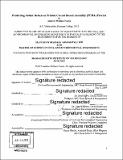| dc.contributor.advisor | Dr. Retsef Levi and John Williams. | en_US |
| dc.contributor.author | Foster, Andrew Wallace. | en_US |
| dc.contributor.other | Sloan School of Management. | en_US |
| dc.contributor.other | Massachusetts Institute of Technology. Department of Civil and Environmental Engineering. | en_US |
| dc.contributor.other | Leaders for Global Operations Program. | en_US |
| dc.date.accessioned | 2019-10-11T22:24:42Z | |
| dc.date.available | 2019-10-11T22:24:42Z | |
| dc.date.copyright | 2019 | en_US |
| dc.date.issued | 2019 | en_US |
| dc.date.issued | 2019 | en_US |
| dc.identifier.uri | https://hdl.handle.net/1721.1/122584 | |
| dc.description | Thesis: M.B.A., Massachusetts Institute of Technology, Sloan School of Management, 2019, In conjunction with the Leaders for Global Operations Program at MIT | en_US |
| dc.description | Thesis: S.M., Massachusetts Institute of Technology, Department of Civil and Environmental Engineering, 2019, In conjunction with the Leaders for Global Operations Program at MIT | en_US |
| dc.description | Cataloged from PDF version of thesis. | en_US |
| dc.description | Includes bibliographical references (pages 72-76). | en_US |
| dc.description.abstract | Printed circuit boards (PCBs) are core components of virtually every modern electronic device, from smartphones to servers. Accordingly, printed circuit board assembly (PCBA) has become core to Flex, a leading electronics manufacturing services (EMS) company. As the EMS industry continues to automate the PCBA process, it captures more data and creates opportunities to leverage this data and to generate value through analytics. One such promising opportunity is using defect prediction to improve downstream yields. For instance, x-ray inspection, which mostly detects solder defects, has a yield of about 97% for one of Flex's automated PCBA lines, and an improvement even to just 98% would create significant cost savings. Given this opportunity, this project aims to use the new data captured by the first steps in the automated PCBA process to predict solder defects that are usually identified during inspection, several days after the board begins the PCBA process. Specifically, the proposed boosted trees model uses data on 20,000 solder pads to predict whether an entire board will fail a downstream x-ray test. Other, more granular models are also studied, as well as other predictive models such as logistic regression and convolutional neural network models. The model is able to identify defective PCBs with an AUC of 0.74 and improve x-ray inspection yields from 97% to 98%, using one PCBA line at Flex as a case study. A second additional use case would reduce the number of x-ray inspection machines needed. Furthermore, a pilot implementation demonstrated that the model works well enough to enable these savings to be realized in practice. At the site where this study was conducted, these two use cases are estimated to produce significant savings over the seven-year useful life of the PCBA machinery. Since Flex has over 1,500 PCBA sites, the results of this case study suggest that there is potential to scale these analytics and related savings across the company. | en_US |
| dc.description.statementofresponsibility | by Andrew Wallace Foster. | en_US |
| dc.format.extent | 76 pages | en_US |
| dc.language.iso | eng | en_US |
| dc.publisher | Massachusetts Institute of Technology | en_US |
| dc.rights | MIT theses are protected by copyright. They may be viewed, downloaded, or printed from this source but further reproduction or distribution in any format is prohibited without written permission. | en_US |
| dc.rights.uri | http://dspace.mit.edu/handle/1721.1/7582 | en_US |
| dc.subject | Sloan School of Management. | en_US |
| dc.subject | Civil and Environmental Engineering. | en_US |
| dc.subject | Leaders for Global Operations Program. | en_US |
| dc.title | Predicting solder defects in printed circuit board assembly (PCBA) process | en_US |
| dc.title.alternative | Predicting solder defects in PCBA process | en_US |
| dc.type | Thesis | en_US |
| dc.description.degree | M.B.A. | en_US |
| dc.description.degree | S.M. | en_US |
| dc.contributor.department | Sloan School of Management | en_US |
| dc.contributor.department | Massachusetts Institute of Technology. Department of Civil and Environmental Engineering | en_US |
| dc.contributor.department | Leaders for Global Operations Program | en_US |
| dc.identifier.oclc | 1119391584 | en_US |
| dc.description.collection | M.B.A. Massachusetts Institute of Technology, Sloan School of Management | en_US |
| dc.description.collection | S.M. Massachusetts Institute of Technology, Department of Civil and Environmental Engineering | en_US |
| dspace.imported | 2019-10-11T22:24:41Z | en_US |
| mit.thesis.degree | Master | en_US |
| mit.thesis.department | Sloan | en_US |
| mit.thesis.department | CivEng | en_US |
